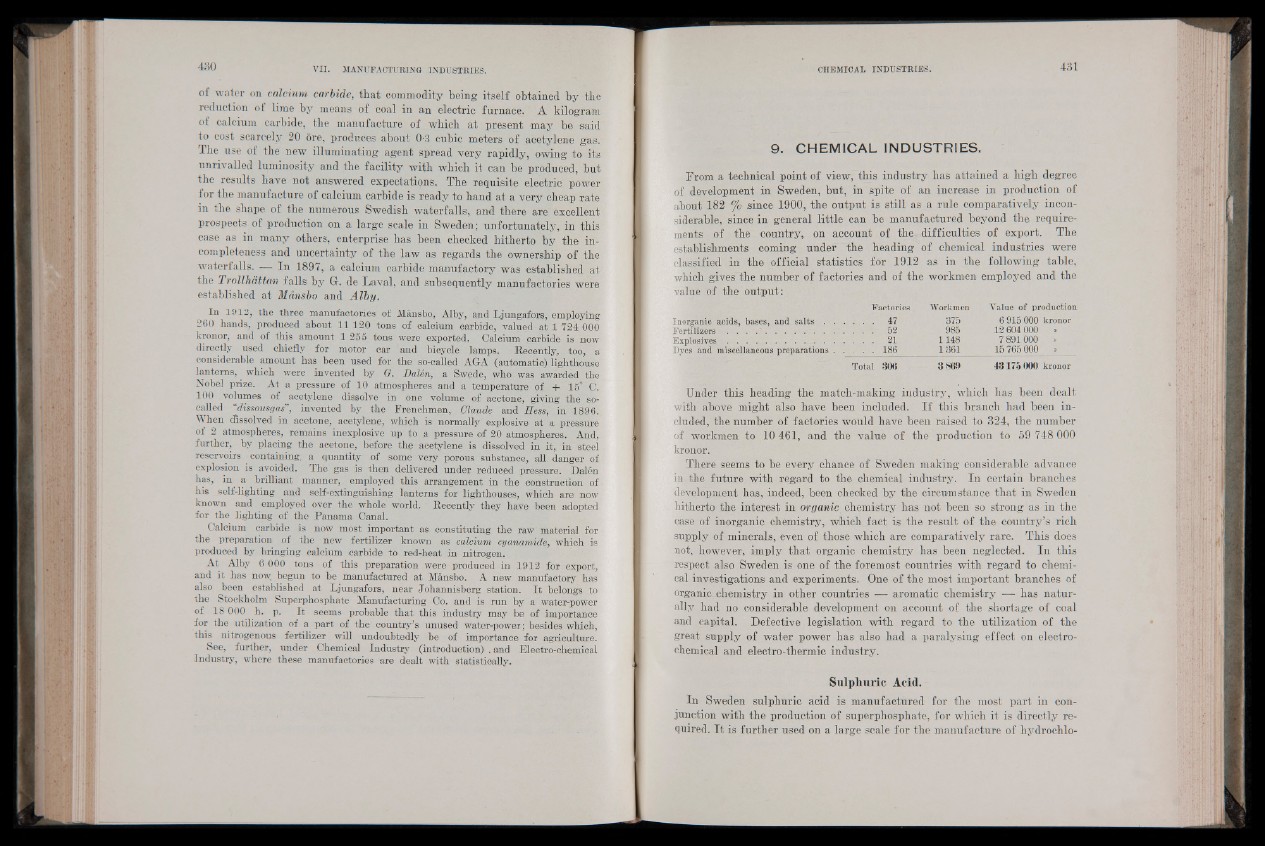
of water on calcium carbide, that commodity being itself obtained by the
reduction of lime by means of coal in an electric furnace. A kilogram
of calcium carbide, the manufacture of which at present may be said
to cost scarcely 20 ore, produces about 0-3 cubic meters of acetylene gas.
The use of the new illuminating agent spread very rapidly, owing to its
unrivalled luminosity and the facility with which it can be produced, but
the results have not answered expectations. The requisite electric power
for the manufacture of calcium carbide is ready to hand at a very cheap rate
in the shape of the numerous Swedish waterfalls, and there are excellent
prospects of production on a large scale in Sweden; unfortunately, in this
case as in many others, enterprise has been checked hitherto by the incompleteness
and uncertainty of the law as regards the ownership of the
waterfalls. — In 1897, a calcium carbide manufactory was established at
the Trollhattan falls by G\ de Laval, and subsequently manufactories were
established at Mansbo and A lby,
In 1912, the three manufactories of Mansbo, Alby, and Ljtmgafors, employing
260 hands, produced about 11 120 tons of calcium carbide, valued at 1 724 000
kronor, and of this amount 1 255 tons were exported, Calcium carbide is now
directly used chiefly for motor car and bicycle lamps, Recently, too, a
considerable amount has been used for the so-called AGA (automatic) lighthouse
lanterns, which were invented by G, Dalen, a Swede, who was awarded the
Nobel prize. At a pressure of 10 atmospheres and a temperature of + 15° 0.
100 volumes of acetylene dissolve in one volume of acetone, giving the so-
called “dissousgas”, invented by the Frenchmen, Clayde and Hess, in 1896.
When dissolved in acetone, acetylene, which is normally explosive at a pressure
of 2 atmospheres, remains inexplosive up to a pressure of 20 atmospheres. And,
further, by placing the acetone, before the acetylene is dissolved in it, in steel
reservoirs containing, a quantity of some very porous substance, all danger of
explosion is avoided. The gas is then delivered under reduced pressure. Dalen
has, in a brilliant manner, employed this arrangement in the construction of
his self-lighting and self-extinguishing lanterns for lighthouses, which are now
known and employed over the whole world. Recently they have been adopted
for the lighting of the Panama Canal.
Calcium carbide is now most important as constituting the raw material for
the preparation of the new fertilizer known as calcium cyanamide which us
produced by bringing calcium carbide to red-heat in nitrogen.
At Alby 6 000 tons of this preparation were produced in 1912 for export,
and it has now. begun to be manufactured at Mansbo. A new manufactory has
also been established at Ljungafors, near Johannisberg station. It belongs to
the Stockholm Superphosphate Manufacturing Co. and is run by a water-power
of 18 000 h. p. It seems probable that this industry may be of importance
for the utilization of a part of the country’s unused water-power; besides which,
this nitrogenous fertilizer will undoubtedly be of importance for agriculture.
See, further, under Chemical Industry (introduction) , and Electro-chemical
Industry, where these manufactories are dealt with statistically.
9. CHEMICAL INDUSTRIES.
From a technical point of view, this industry has attained a high degree
of development in Sweden, hut, in spite of an increase in production of
about 182 % since 1900, the output is still as a rule comparatively inconsiderable,
since in general little can be manufactured beyond the requirements
of the country, on account of the. difficulties of export. The
establishments coming under the heading of chemical industries were
classified in the official statistics for 1912 as in the following table,
which gives the number of factories and of the workmen employed and the
value of the output:
Factories Workmen Value of production
Inorganic acids, bases, and salts . ................ 47 375 6 915 000 kronor
Fertilizers . . . . ‘ . . . . . . . — . 52 985 12 604 000 >
Exp lo siv e s............................... ................ 21 1148 7 891 000 »
Dyes and miscellaneous preparations ................186 1 361 15 765 000 »
Total 306 386» 43175000 kronor
Under this heading the match-making industry, which has been dealt
with above might also have been included. I f this branch had been included,
the number of factories would have been raised to 324, the number
of workmen to 10 46.1, and the value of the production to 59 748 000
kronor.
There seems to be every chance of Sweden making considerable advance
in the future with regard to the chemical industry. In certain branches
development has, indeed, been checked by the circumstance that in Sweden
hitherto the interest in organic chemistry has not been so strong as in the
oase of inorganic chemistry, which fact is the result of the country’s rich
supply of minerals, even of those which are comparatively rare. This does
not, however, imply that organic chemistry has been neglected. In this
respect also Sweden is one of the foremost countries with regard to chemical
investigations and experiments. One of the most important branches of
organic chemistry in other countries aromatic chemistry — has naturally
had no considerable development on account of the shortage of coal
and capital. Defective legislation with regard to the utilization of the
great supply of water power has also had a paralysing effect on electrochemical
and electro-thermic industry.
Sulphuric Acid.
In Sweden sulphuric acid is manufactured for the most part in conjunction
with the production of superphosphate, for which it is directly required.
It is further used on a large scale for the manufacture of hydrochlo